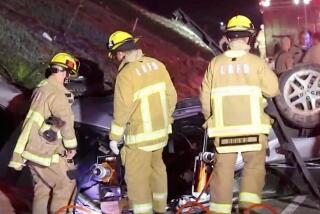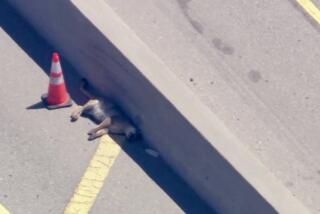Freeways’ Missing Links Can Frustrate Commuters
David Kriske is having a torrid on-again, off-again affair. With freeways.
Consider his daily commute from Burbank to Beverly Hills: Moments after the 25-year-old database analyst zooms up a freeway onramp, he is downshifting his Acura Integra and heading for an exit.
Then Kriske chugs along a mile of city streets before ramping on to another freeway. But before long, he’s rushing for an offramp and surface streets again. He’ll repeat the process a third time before his drive is over.
It’s not that Kriske is the waffling kind of guy who can’t commit. It’s just that the three freeways that zigzag him toward work--the Golden State south, the Ventura west and the Hollywood south--cross each other but lack connecting ramps that funnel him in a direct, unbroken arc.
“It’s frustrating is what it is,” Kriske said. “The fact that I have to get off the freeway to get back on is an annoyance.”
The ups and downs of freeway driving are a way of life for many motorists in Southern California.
In Los Angeles County, at least 36 connectors are absent at 13 freeway intersections, while 11 freeway crossings in Orange County may seem incomplete because 17 connector ramps were never built, according to the California Department of Transportation. Nine connectors are missing from San Diego County’s freeways, though one is under construction now.
Because of the obvious inconvenience to drivers--not to mention the nuisance of cut-through traffic in neighborhoods--some wonder whether transportation engineers might have accidentally deleted something from their construction blueprints.
“I can’t see any rhyme or reason to it. It doesn’t make any sense,” said Oliver Comings, 28, of Studio City, who said he has gotten confused and lost many times when he couldn’t turn from freeway to freeway. “Somebody obviously dropped the ball.”
But transportation experts say missing freeway connectors aren’t mistakes or the result of bad engineering. “There’s generally a very good reason for it,” said Chuck O’Connell, a freeway historian and retired Caltrans deputy district director.
A connector might be omitted if it involves an illogical “reverse move,” where the freeways cross at an acute angle, experts say. An example is the northbound Long Beach Freeway to the southbound Santa Ana Freeway in the City of Commerce. If a car cruising north on the Long Beach Freeway wanted to turn south on the Santa Ana Freeway, it would have to make the equivalent of a giant U-turn.
Some freeway intersections huddle so close together they are expected to share connectors. That describes the Ronald Reagan Freeway, which intersects with the Golden State and San Diego freeways about 1 1/2 miles apart. There is no connecting ramp from the eastbound Ronald Reagan Freeway to the northbound Golden State Freeway, for instance. That’s because Caltrans wants drivers to connect to the San Diego Freeway north, then immediately merge onto the Golden State Freeway north.
A third reason for absent connectors is insufficient traffic volume. When the new California 56 extension in the Carmel Valley area of San Diego County opens in 2004, the freeway will not have connectors for cars going from California 56 west to the San Diego Freeway south, or from the San Diego Freeway north to California 56 east. Despite the communities’ urging, Caltrans is omitting those two ramps because they would cost $140 million but serve only 1,000 vehicles a day, said Tom Nipper, an agency spokesman.
But freeways that remain unconnected also impose costs, experts say. They waste drivers’ time. Cut-through traffic worsens congestion, increases air pollution and possibly causes more accidents on city streets. These are “impacts that don’t lend themselves to easy quantification,” said Robert W. Poole, director of transportation studies at Reason Public Policy Institute in Los Angeles.
There’s also the added noise.
Comings, a singer with a heavy metal group, happens to live with his bandmates near the Ventura and Hollywood freeways’ interchange, which lacks four connectors. There is no freeway-to-freeway access, for example, from the Hollywood Freeway north to the Ventura Freeway east.
One of the designated detour streets for that missing connector is Vineland Avenue, right next to Comings’ house. “It’s soooooooo loud,” he said as a steady stream of cars and big rigs rumbled by. His band, None, moved to the house a few months ago, figuring neighbors wouldn’t be able to hear their banging drums and screaming guitar riffs over the roar of traffic.
“If it wasn’t for the music situation, [the noise] would drive me insane,” Comings said. “It’s brutal.”
The missing connectors in Studio City are a special case. In the early 1950s, when the Hollywood Freeway was under construction, designers deliberately put some ramp plans on hold until the adjacent “Laurel Canyon Freeway” could be built because “all the connectors would have logically tied in,” said O’Connell, the freeway historian.
But the Laurel Canyon Freeway, like hundreds of miles of other freeways proposed for Los Angeles County, never got built. “So, unfortunately, we’re stuck,” O’Connell said.
Also feeling pinched are the residents near the Golden State and Ventura freeways’ interchange in the Glendale-Los Angeles area, who say they’re sick of cars cutting through their neighborhood because the Ventura Freeway east does not connect with the Golden State Freeway north, nor does the Golden State Freeway south with the Ventura Freeway west.
Some drivers speed as if they’re still on the freeway, and that endangers neighborhood children, said Maria Jesus Lara, a 53-year-old grandmother. “It’s bad,” she said. “One day, maybe they’ll fix it.”
Lara and others shouldn’t hold their breath. Caltrans studied the location and--by matching car license plates at two freeway exits--found that only about 100 cars per hour were cutting through the neighborhood during peak commute times. The agency concluded that the volume was not heavy enough to justify the high cost of building a new connector, said Tom Choe, Caltrans chief of freeway operations for Los Angeles and Ventura counties.
Those who live in the area dispute those low figures. Hopes were dashed when a different study--sponsored by Los Angeles, Glendale and Burbank, which is also near the interchange--found it would be too complicated, costly and disruptive to build the connectors anyway because of the area’s special geography. The connectors would have to skirt the Los Angeles River and force the demolition of many homes.
“Perhaps it would not be worth it,” said Kriske, now resigned to wishful thinking about smooth driving on freeways. Still, he said, “it’s a substandard way to navigate.”
More to Read
Sign up for Essential California
The most important California stories and recommendations in your inbox every morning.
You may occasionally receive promotional content from the Los Angeles Times.









